The National Archives’ collection of modern materials includes photographs, plastics, films and transparent papers. Understanding more about these materials helps us decide how best to care for them; this can mean controlling the conditions in which they are stored as well as treating any damage that occurs during their lifetime.
Extensive research has told us a great deal about parchment and more common types of paper, but much less is known about transparent papers: those that were intended to be transparent in order to fulfil a specific purpose – such as tracing papers – as opposed to papers that are merely very thin. We set out to survey the transparent papers in our collection in the hope of better understanding the relationship between their colour and their brittleness, and recruited a group of seven volunteers to help us with the work. Over 22 months they will be surveying more than 2,500 papers; these range from very small items bound into books or tagged into files to pieces over a metre long.
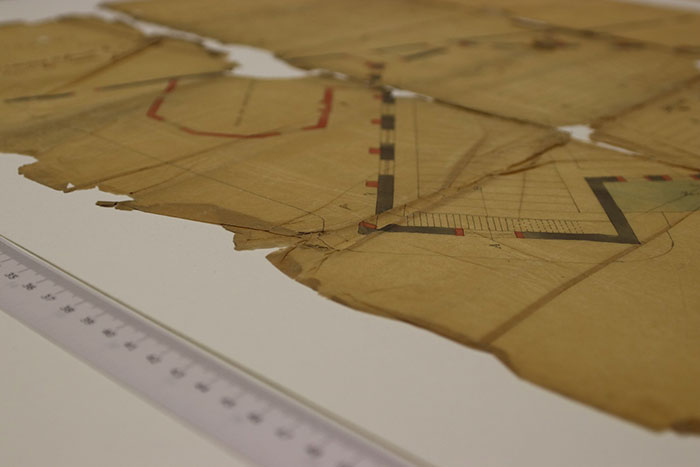
Sample of Transparent Papers being surveyed
With senior conservation manager Helen Wilson, I had to decide which questions we needed to answer, as well as how we were going to record the information and the training that the volunteers would need. We encountered many challenges, but finally put together a plan. We gave the volunteers an overview of the project and trained them in how to handle the documents they would encounter, how to use a scale to determine the colour of different papers, and how to fill in the survey questionnaire that we had designed. We had decided to use an online survey tool to focus the volunteers’ work on the important questions of colour and brittleness, and to avoid ending up with a spreadsheet full of other information; we also wanted to be able to present the results in a variety of different ways, including graphs and charts. We knew that the questionnaire was a work in progress, but until we started working with it we had no way of knowing how far it still had to come!
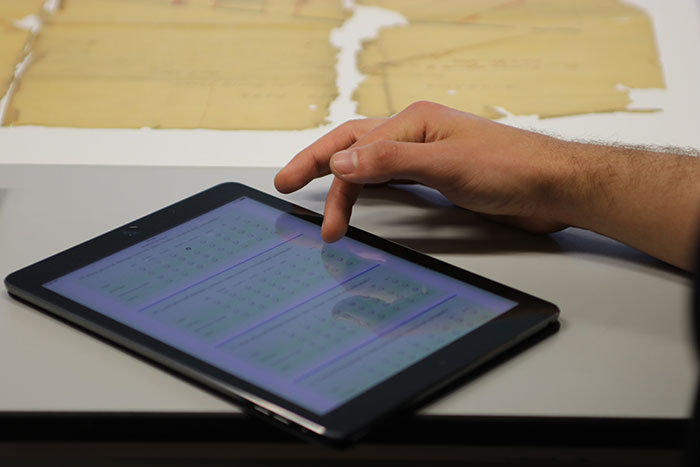
Online surveying
From July 2017 the volunteers began coming in weekly, and soon got to grips with handling a wide range of documents, and with using colour charts and iPads to answer the survey’s 25 to 30 questions. We encouraged them to give feedback on what worked and what didn’t, and to share their ideas on how the survey could be improved. It soon grew to include around 50 questions, as we tried to perfect the measuring scales used to define the papers’ colour and damage. At one stage we had four different versions of the damage scale, but with the volunteers’ help were able to settle on one. It was important that everyone understood the project and the significance of the work they were doing.
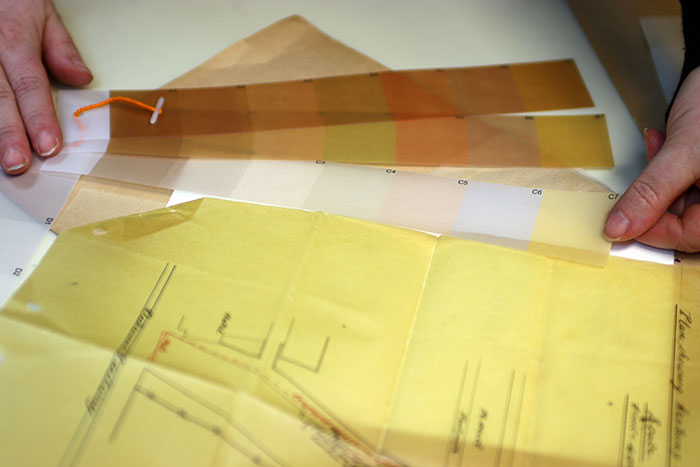
Using the colour scale
We soon recognised that the volunteers all worked slightly differently; some preferred to assess damage in terms of percentages while others took a less mathematical approach. To allow for these differences we came up with a crib-sheet that allowed assessment by percentages, words and even emojis.
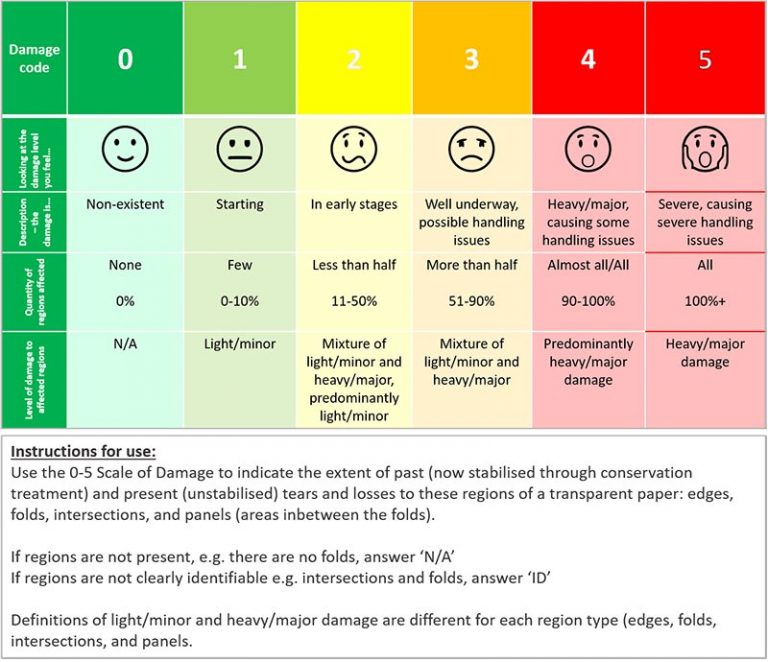
Damage scale including emojis
Taking the volunteers’ feedback into consideration helped them feel involved in the process – on many occasions they asked us whether the survey was producing useful information! Training and communication has helped their confidence grow, to the point where they can work more independently as time passes.
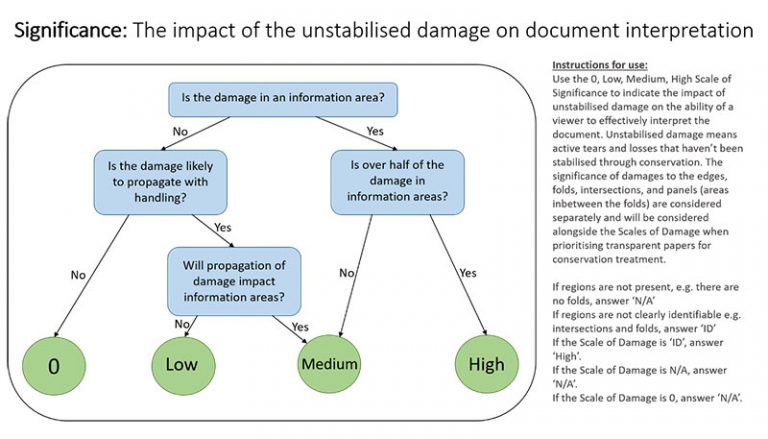
Flowchart: the impact of unstabilised damage on document interpretation
The trial period ended at the beginning of October 2017 and, although we’ve yet to begin thoroughly analysing the data, the initial results look promising. An interesting 18 months lies ahead as we look into which of our transparent papers are most in need of conservation.
What do the volunteers have to say about the project?
‘Every Wednesday is a “Lucky Dip” day, as you don’t know what the next document you will be looking at is about, but there’s no need to worry – they are all interesting! I recently opened a folder to find an artist’s depiction of the Exhibition in Crystal Palace Park (moved there from Hyde Park in the 1860s) with useful information about public transport routes to the exhibits in the grounds. I love the small property maps bound into the Land Tax volumes (IR 24/185) and I hope to publicise their existence to my fellow family historians.
‘I’m surprised at how well some transparent papers have withstood age and use over time. Some have benefited from earlier conservation, of course – others have been used less frequently and remain sturdy. Equally, I’m surprised at how brittle transparent papers can become and I now appreciate the threat of inappropriate care and storage.
‘I find some of the terminology used naturally by archivists is a bit confusing to a lay person like me. Helen’s notes are very helpful here and it’s very reassuring to have Stephanie and Helen on hand to advise.’
Anne Ramon
‘I’ve enjoyed the way you’ve let us – the volunteers – help work out with you – the professionals – how to set up the project, how to devise the questionnaire, how to iron out problems, etc.
Of the material we’ve looked at, the drawings done on transparent paper over printed maps to guide the day-to-day conduct of the 1914-18 war have been particularly interesting.
‘It’s surprising how difficult it is to decide whether particular documents are transparent paper or not: a bit like the photo project where we often couldn’t decide whether something was a photograph or not – and, indeed, what it was that made it a photograph rather than some other form of copying. Likewise, there are a number of drawings and tracings which, when we look at them, are like transparent paper documents but don’t actually qualify. Many near misses!
‘For the project as a whole rather than me as a volunteer, the biggest challenge is to be able to work out where the files and folders containing transparent paper documents are located. It’s difficult to know what proportion of the Archive’s transparent collection we’ll eventually be able to review, depending as we do on whatever happens to find its way onto our trolleys each week.’
Vivian Brown
‘There have been several interesting aspects to the project so far. It was good to be involved with the evolution of the method of analysing the transparencies. This was a tremendous help in understanding what you and Helen were looking for. It’s also interesting to identify the range of uses of transparencies.
‘The most surprising aspect for me is the range and breadth of files that hold transparencies. This is great as we get to look at some wonderful files and get to know the collection a lot better. Every week is different.
‘The most challenging aspect, as with the photo project, is to identify what is a transparency. It can be challenging to locate them as you really have to check each file thoroughly – as they are so thin, they can hide easily. They can also be extremely fragile. This is a big challenge when handling them and can be daunting.’
Pauline Bittles
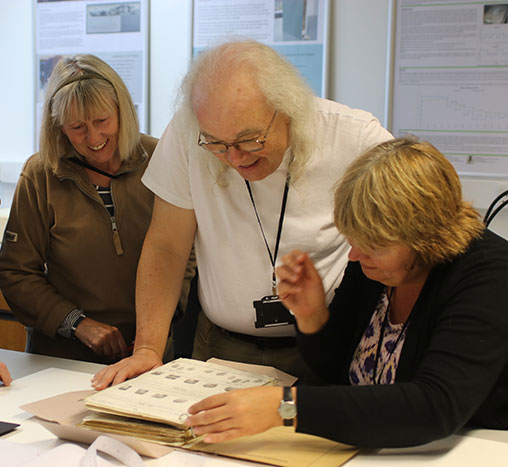
Volunteers surveying in Collection Care
Image credits: photographs by Jacqueline Moon, diagrams by Dr Helen Wilson
[…] Surveying our transparent papers: volunteers in Collection Care […]